Garden and lawn weeds come in all shapes, sizes, and colors. Some garden weeds have purple flowers, others have small yellow flowers, and then there are some that have pink and white flowers. However, none of them look as unpleasant as the spiky weeds. These prickly and thorny plants are difficult to remove and can also give you a nasty wound if you accidentally come into contact with them.
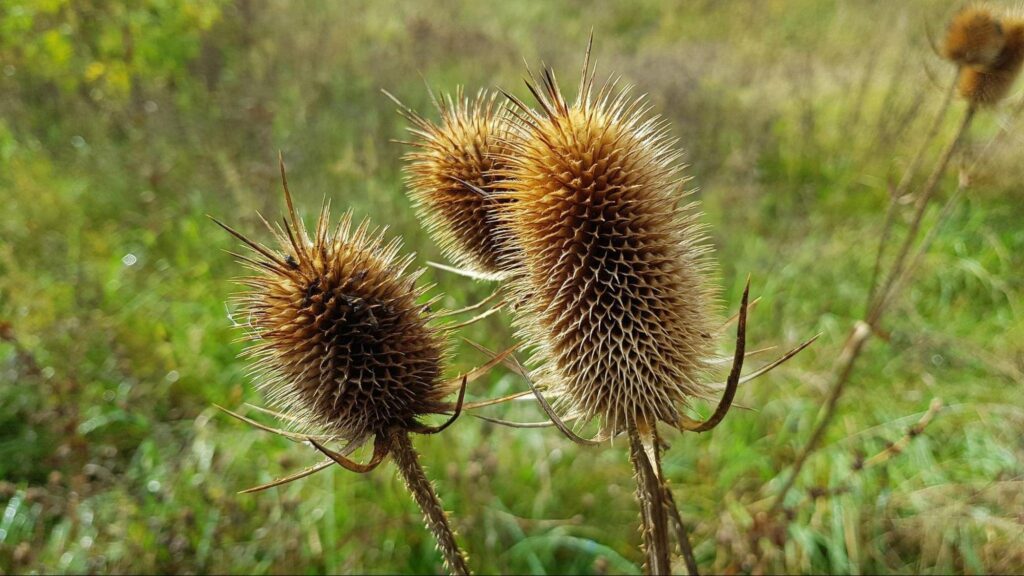
Common Teasel: A biennial or perennial weed that dies after producing seed.
Besides being physically and aesthetically discomforting, these prickly weeds can sometimes grow quite aggressively, quickly occupying the entire lawn. They also compete with other plants for space, water, nutrients, and sunlight. If not taken care of in time, soon you will literally have a garden bed made of thorns.
In this article, we will tell you about the most common spiky weeds that you might come across in your lawn and garden. Some of these weeds only have spines on their stems or leaves. However, some are covered in spines from top to bottom.
In fact, some of these noxious weeds might even have spines on their fruits and flowers.
This article also includes an identification guide for each type of garden weed mentioned. So you have no difficulty in determining what kind of garden weed you are dealing with in your home.
Also, we have mentioned some of the most effective control methods and management strategies to help you prevent weeds from taking over your precious flower beds. Happy reading!
Related: Common Lawn Weeds With White Flowers (And How To Get Rid Of Them?)
Common Spiky Weeds
Canada Thistle
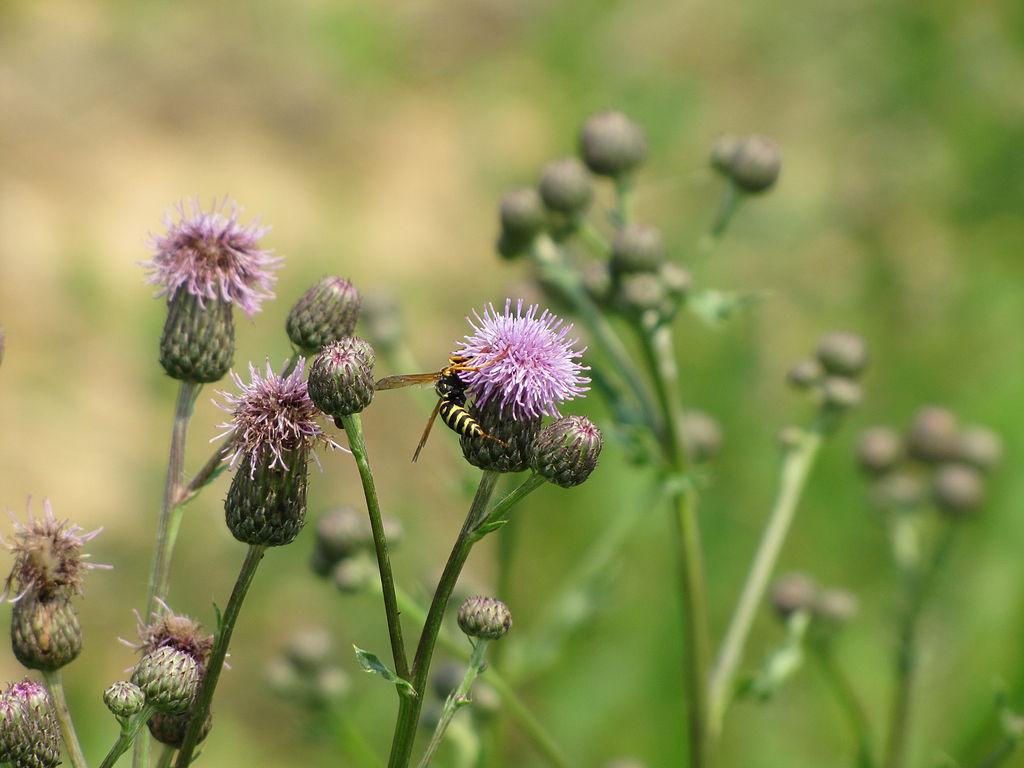
Canada thistle: a declared noxious weed of Ireland, New Zealand, United States, Brazil, China, and Canada.
Despite its name, the Canada thistle is native to Europe and Asia. It is the most widespread of all thistle species. It spreads quickly, forms an extensive root system, and has a tendency to make monocultures, reducing biodiversity.
The plant grows by its root system and network of creeping stems. Livestock animals avoid feeding on it, which adds to its dominance in fields and pastures. Sometimes, animals also get scratched by its sharp spines, resulting in minor infections.
Canada thistle is difficult to control once established. Depending on the site, a combination of control strategies might be needed to reduce its spread. Planting competitive crops and maintaining a thick lawn can help you reduce the chances of its infestation.
Canada Thistle Quick Facts
| Scientific Name | Cirsium arvense |
| Other Names | Field thistle, creeping thistle |
| Weed Type | Perennial |
| Height | 2 to 5 feet |
| Flowering & Leaves | – Flowers bloom from June to October – Flowers are borne at the end of stems and are pink, purple, or white – Leaves are irregularly lobed and lance-shaped |
| Distribution & Habitat | – Prefers sunny disturbed areas – Frequently invades prairies, barrens, savannas, ditches, pastures, and hayfields |
Related: Top 10 Weeds With Purple Flowers (And How To Get Rid Of Them?)
Jimsonweed
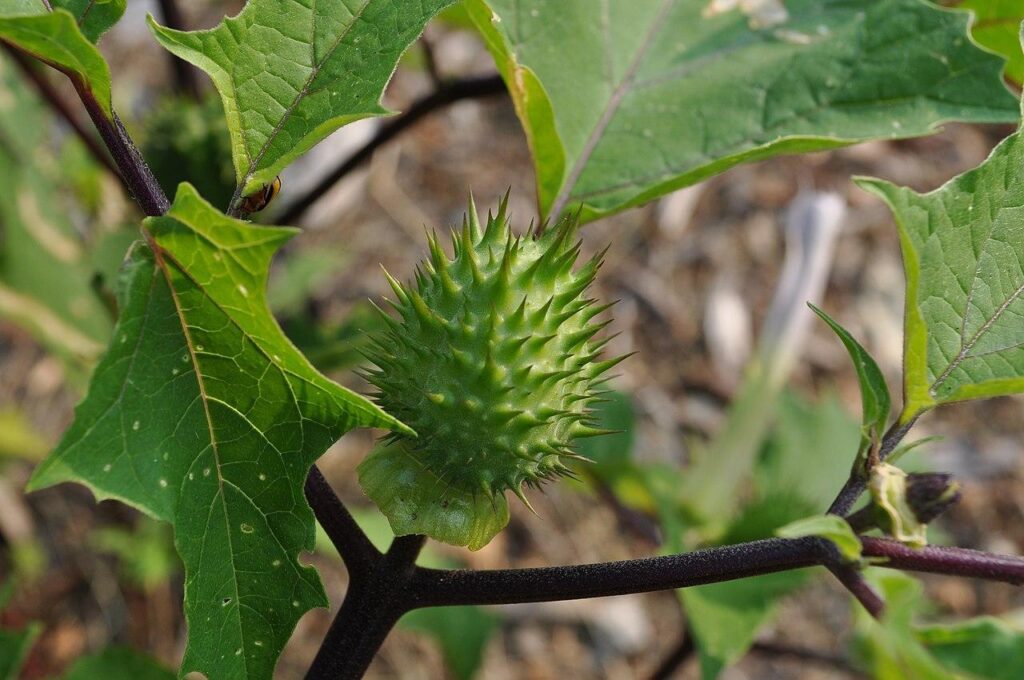
Jimson Weeds produce fruit encased in a spiny coat.
Due to the presence of certain alkaloids, the entire plant of Jimsonweed is poisonous, especially the seeds. Jimsonweed grows quite rapidly and competes very aggressively with other garden plants. The weed has egg-shaped fruits that are covered with many stout spines. The weed gets its name from Jamestown, Virginia, where it was used in the mid-1600s to pacify distressed soldiers.
The weed reproduces by seeds, and they can spread quickly and very far from the parent plant. The best way to avoid an infestation is to prevent seeds from spreading or uproot the plants before they set seed. For already established plants, you can use a broadleaf herbicide.
Jimsonweed Quick Facts
| Scientific Name | Datura stramonium |
| Other Names | Thorn apple, devil’s trumpet, devil’s snare, |
| Weed Type | Annual weed |
| Height | Around one to two meters |
| Flowering & Leaves | – Generally, flowers throughout the summer – Flowers have a pleasant smell and are pinkish-white in color – Leaves are soft, smooth, toothed, and highly undulated |
| Distribution & Habitat | – Originated in Central America – Introduced and widespread throughout the world – Habitats include waste areas, fields, cultivated areas, and pastures |
Related: Common Lawn Weeds With Yellow Flowers (And How To Get Rid Of Them?)
Spiny Pigweed
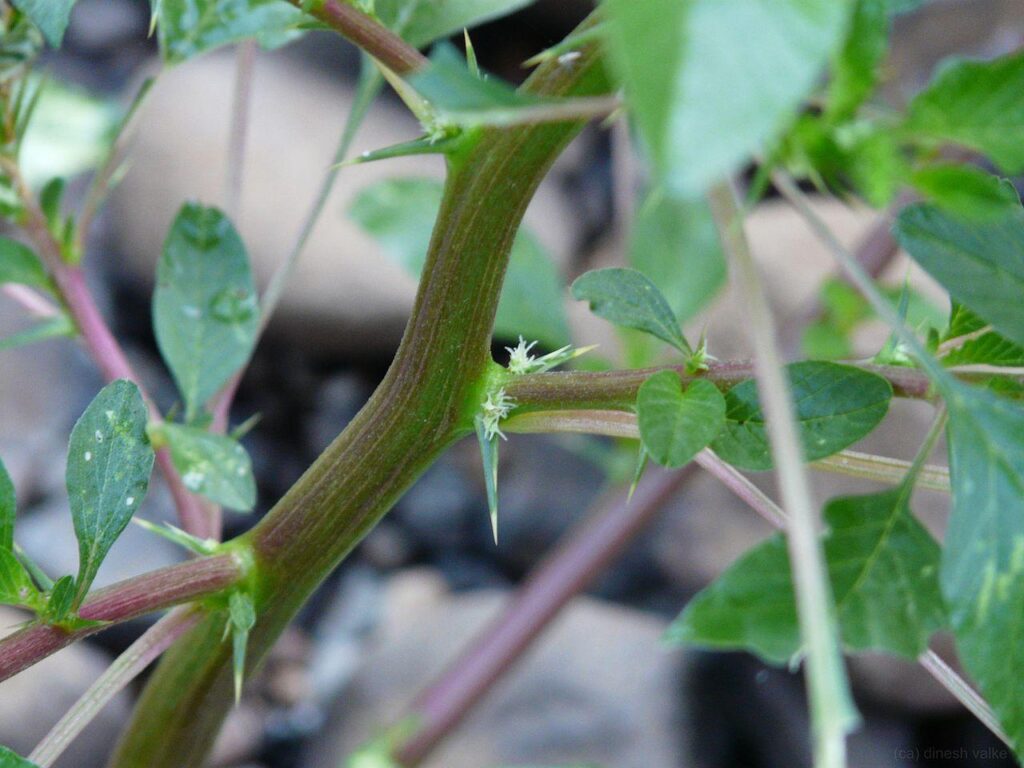
Thorns of a spiny pigweed.
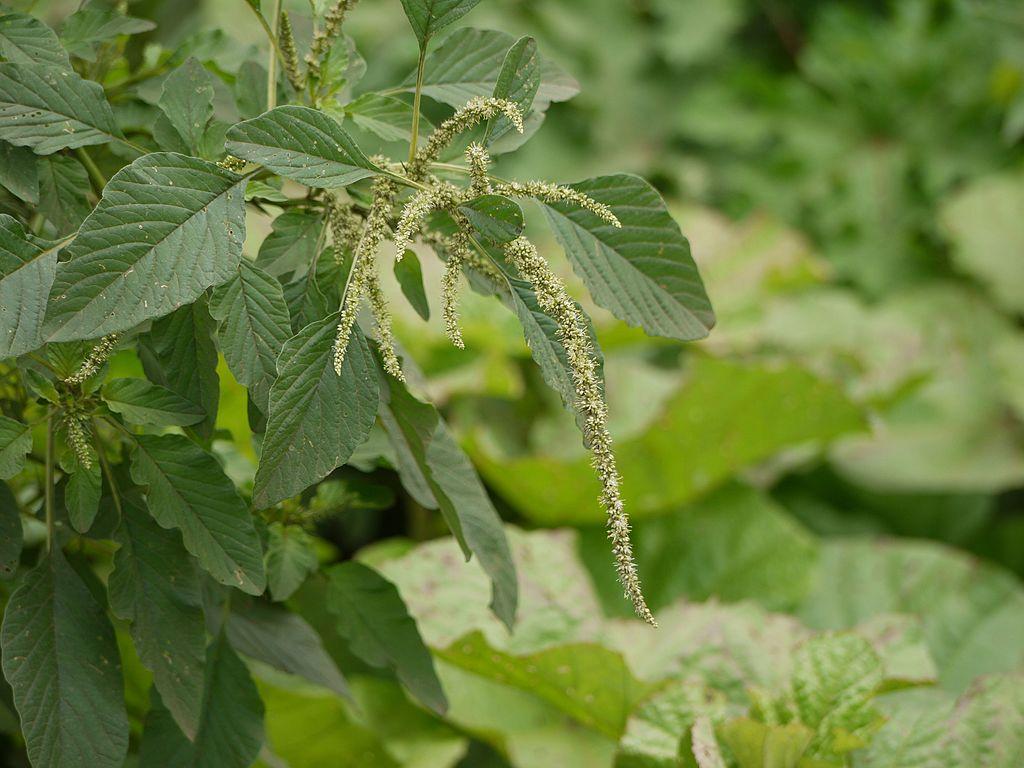
Flowers of a spiny pigweed.
These common garden weeds blend so well with the environment that you do not see them until it’s too late. Its sharp thorns make it unpalatable to livestock, and it can become quite a nuisance in agricultural lands, lawns, and fields. Also, the spiny pigweed is toxic for cattle and other livestock as it contains nitrates which turn into nitrites in the rumen.
Weed control in the case of spiny pigweed involves regular mowing, which can suppress seed production.
However, these plants produce seeds very prolifically, and even beat-up plants can produce weed seeds occasionally. Therefore, your best bet is to use chemical herbicides to avoid and tackle an infestation.
Spiny Pigweed Quick Facts
| Scientific Name | Amaranthus spinosus |
| Other Names | Prickly amaranth, spiny amaranth, and thorny amaranth |
| Weed Type | Summer annual weed |
| Height | Up to five feet |
| Flowering & Leaves | – Flowering occurs during late summer and autumn – Flowers form in clusters and are bristly looking – Plant has light green leaves with an oval shape |
| Distribution & Habitat | – Native to the tropical Americas – Introduced and fairly dispersed in most continents – The invasive weed prefers soils rich in nitrogen and organic matter |
Lawn Burweed
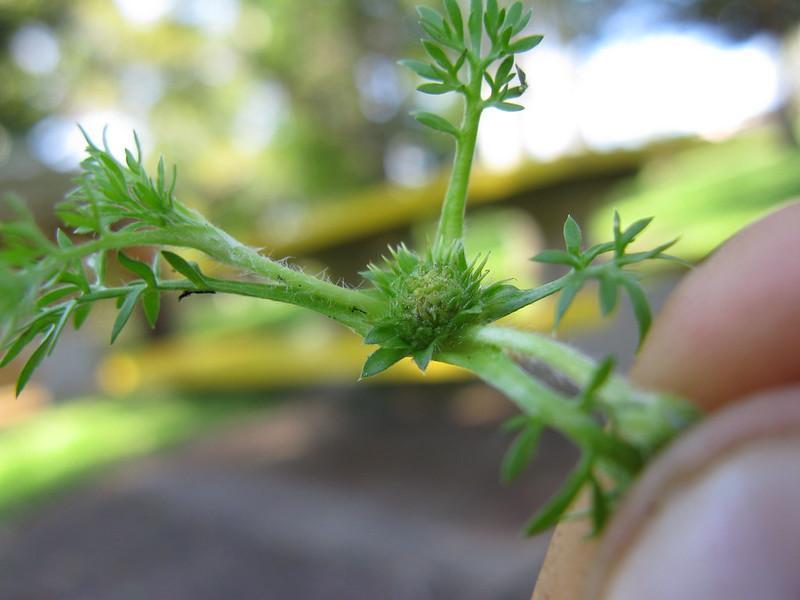
Hand pulling to eradicate lawn burweed is not suggested because of its spines.
Nothing ruins a pleasant experience of walking barefoot on lawn grass like the presence of lawn burweed. These common weeds are considered noxious in 46 states. They remain dormant and conspicuous during the cold winter months. However, when the temperatures rise in early spring, lawn burweed grows very rapidly and forms spine-tipped burs.
At this point, weed control is not feasible as the plant has already set seed for ensuring another crop of the new plant next year. Fortunately, maintaining a weed-free lawn in the case of lawn burweed is relatively easy. Both pre-emergent and post-emergent herbicides have proven helpful in controlling lawn burweed growth.
Lawn Burweed Quick Facts
| Scientific Name | Soliva sessilis |
| Other Names | Common soliva, bindi weed, field burweed, Onehunga-weed |
| Weed Type | Broadleaf annual weed |
| Height | 3 to 4 inches |
| Flowering & Leaves | – Small yellow flowers that are inconspicuous and spiny – Leaves are feathery and have the appearance of parsley |
| Distribution & Habitat | – Native to South America. Introduced and distributed worldwide – Declared invasive species in North Carolina |
Prickly Sida
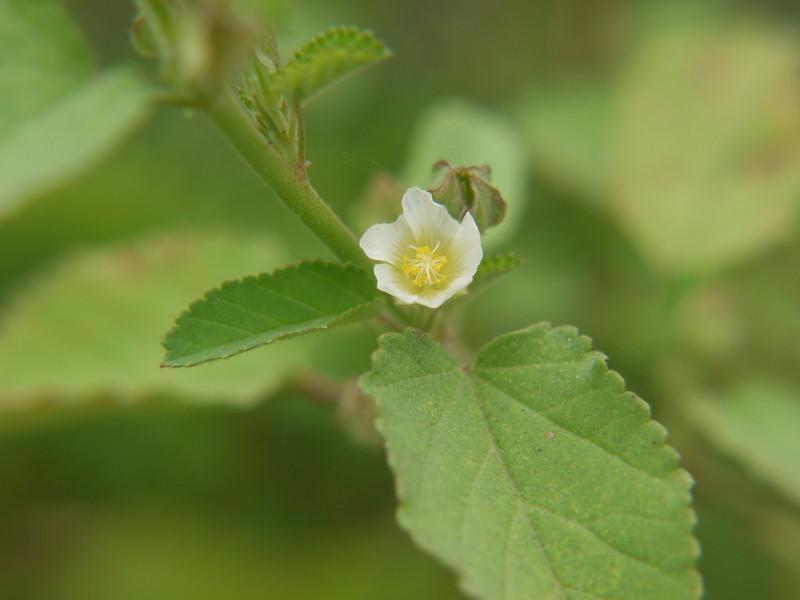
Perennial weeds that are usually found in waste areas.
Prickly sida is one of the most troublesome and common weeds of cotton, peanuts, and soybeans in some southern states of the USA. The weed is usually found in waste areas; however, it can be very competitive in pastures if present. It is because livestock animals generally avoid grazing on it because of its sharp hairs and spines.
Hand pulling and mulching during the warm weather can prevent prickly sida from becoming a problem in the lawn and garden. However, if the infestation is heavy, mow frequently to reduce the chances of spreading weed seeds. The use of broadleaf herbicides in agricultural settings has proven beneficial to control prickly sida infestations.
Prickly Sida Quick Facts
| Scientific Name | Sida rhombifolia |
| Other Names | Arrowleaf sida, Paddy’s lucerne, Jelly leaf, Queensland hemp, Cuban jute, Indian hemp |
| Weed Type | Perennial |
| Height | Up to 1.5 feet |
| Flowering & Leaves | – Flowers bloom throughout the year – Small yellow flowers with five petals – Leaves are oval with toothed margins |
| Distribution & Habitat | – Widely distributed throughout the eastern and northern hemisphere – Habitats generally include waste areas |
Goat Head Weed
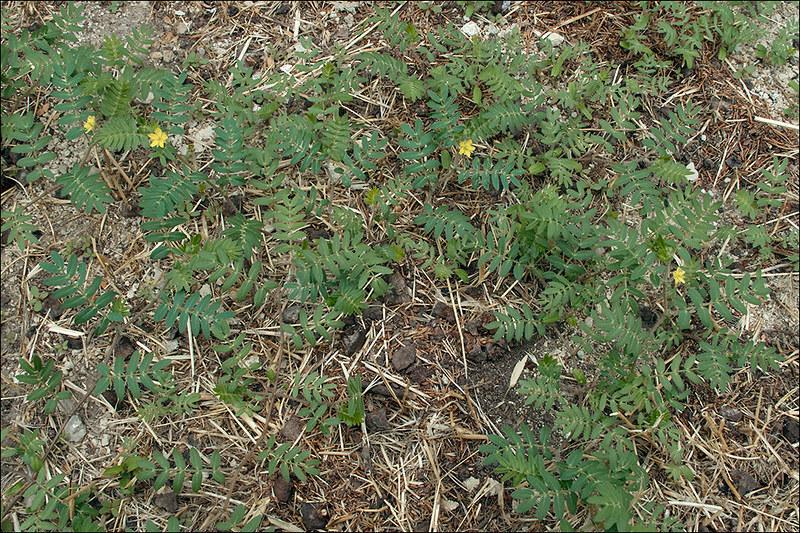
Goat head weed spreads aggressively, forming a thick mat on the soil surface.
It is a highly noxious biennial weed that can easily outcompete local plants, forming monocultures. The plant mainly spreads through its seeds which can lie dormant in the soil for many years. In addition to that, its root system can also give rise to new plants, forming dense mats.
To control goat head weed in your lawn, do not try hand pulling the plants. Its sharp burs can cause serious injuries. Instead, use a garden fork to find and pull weeds out of the ground. Also, remove all the weeds from your lawn and garden before the plant flowers.
Goat Head Weed Quick Facts
| Scientific Name | Tribulus terrestris |
| Other Names | Bindii, bullhead, caltrop, devil’s eyelashes, devil’s-thorn, puncture vine, and tackweed |
| Weed Type | Summer annual weed |
| Height | 2 to 4 inch |
| Flowering & Leaves | – Flowers bloom from July to September – Flowers are bright yellow with five petals – Leaves are small and hairy |
| Distribution & Habitat | – Native to temperate and tropical regions of southern Eurasia and Africa – Introduced and invasive in North America and Australia |
Prickly Lettuce

Prickly lettuce can significantly affect harvesting efficiency and crop quality.
It is a winter annual weed often found along field edges in winter wheat and soybean. Prickly lettuce might be mistaken for dandelion or sow thistle. The plant produces milky sap and wind-dispersed seeds. It is quite drought tolerant and can survive very well in dry soil.
Prickly lettuce can have detrimental effects on crop value and harvesting efficiency. It is because the sticky sap in its stems and roots can clog harvesting machinery and increase the moisture content of the grain. Prickly lettuce is best controlled by the use of herbicides which must be sprayed before the emergence of flowers.
Prickly Lettuce Quick Facts
| Scientific Name | Lactuca serriola |
| Other Names | Milk thistle, compass plant, and scarole |
| Weed Type | Annual or biennial weeds |
| Height | One to five inches |
| Flowering & Leaves | – Flowers bloom from July until September – Flower heads are pale yellow with 15-20 flower rays – Plant has green leaves with spiny leaf edges |
| Distribution & Habitat | – Native to Europe, Asia, and North Africa – Introduced and naturalized elsewhere – Habitats include abandoned fields, vacant lots, dumps, roadsides, etc. |
Common Greenbrier
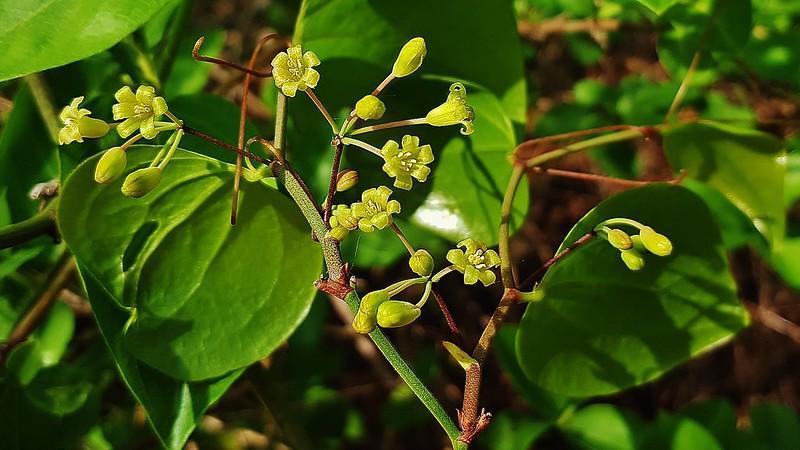
These weedy vines usually grow on the rich soil of ornamental beds and forest floors.
It is difficult to control the weedy vine that grows in landscape areas. These weedy vines can entangle ornamental plants and shrubs. They can grow almost 25 feet tall and are armored with stiff spines.
Common greenbrier plants can grow well in partial shade, allowing these weedy vines to develop rapidly beneath ornamental shrubs. These vines give rise to a very extensive system of rhizomes.
The rhizomes can quickly regenerate even after being burnt, cut, or treated with weed killers. Therefore, the best strategy to avoid an infestation is to prevent their introduction in the first place.
Unfortunately, even most chemical herbicides do not work on them because of the thick waxy coating on mature foliage.
Common Greenbrier Quick Facts
| Scientific Name | Smilax rotundifolia |
| Other Names | Roundleaf greenbrier |
| Weed type | Perennial weed |
| Height | Up to 25 feet |
| Flowering & Leaves | – Flowers bloom from April to August – Flowers are greenish and inconspicuous – Plant has heart-shaped leaves |
| Distribution & Habitat | – Native to parts of the United States and eastern Canada – A inconspicuous part of forest systems and ornamental beds |
Bull Thistle

Flower head of a bull thistle plant.
Bull thistles are one of the most aggressive weeds in the United States. It is spread to 42 states and is declared a noxious weed in 16 states. Livestock animals avoid eating bull thistle plants, giving it a considerable advantage over the native plants and helping it spread freely. Its foliage has a hairy appearance on top and a fluffy wooly look on the bottom.
Since the bull thistle plant reproduces by seeds, controlling seed dispersal is best to avoid its infestation. However, for ongoing infestations, several manual and chemical control options can be implemented depending on the severity of the infestation.
Bull Thistle Quick Facts
| Scientific Name | Cirsium vulgare |
| Other Names | Spear thistle, common thistle |
| Weed Type | Biennial |
| Height | 3 to 7 feet |
| Flowering & Leaves | – Flowering occurs from June to September – Flower heads are large and showy, containing hundreds of tiny purple or pink flowers – Leaves are deeply lobed |
| Distribution & Habitat | – The weed prefers moist, fertile soil such as logged areas, pastures, and cultivated land |
Carolina Horsenettle

Spines of the Carolina horsenettle.
Carolina horsenettle is a warm-season herb subshrub that is considered a weed in many states of the US. It is a tolerant plant that can survive sandy, dry, and wet soil conditions.
It can show aggressive growth in disturbed areas such as roadsides. Carolina horsenettle is also a common weed of corn, small grains, and solanaceous crops, including tomato and potato.
The weed is extremely hard to remove. It spreads via a network of underground rhizomes and is resistant to many post-emergent and other broad-spectrum herbicides.
Gardeners also despise the weed; its sharp spines often break up when touched, piercing the skin and giving nasty wounds to the handler.
Carolina Horsenettle Quick Facts
| Scientific Name | Solanum carolinense |
| Other Names | Radical weed, sand brier, bull nettle, tread-softly, devil’s tomato |
| Weed Type | Perennial |
| Height | Up to 3 feet tall |
| Flowering & Leaves | – Flowers appear during fall and summer – Flowers are star-shaped and purple or white – Leaves are oblong and smell of potatoes when crushed |
| Distribution & Habitat | – Habitats include prairies, yards, gardens, vacant lots, and other waste areas. |
Common Cocklebur

Common cockleburs release toxic chemicals that can prevent seeds of other plants from germinating.
It is a broadleaf summer annual plant often present in moist open disturbed areas and agricultural lands. The plant is known to release chemicals that can inhibit seed germination of other plants and kill off their young seedlings. Common cocklebur is also considered one of the most competitive weeds of soybean crops.
Its thick, woody stems can reduce the efficiency of harvesting. The young seedlings of common cockleburs are also poisonous to livestock animals. A mix of pre-emergent and post-emergent herbicides provides the best results against an infestation of common cockleburs.
Common Cocklebur Quick Facts
| Scientific Name | Xanthium strumarium |
| Other Names | Large cocklebur, woolgarie bur, rough cocklebur, clotbur |
| Weed Type | Annual |
| Height | 6 to 7 feet |
| Flowering & Leaves | – Flowers are small, inconspicuous, and green – Leaves are lobed and have rough hairy surfaces |
| Distribution & Habitat | – Originated in North America and extensively naturalized in other places – Habitats include roadsides, riverbanks, edges of ponds, and overgrazed pastures |
Spiny Sowthistle
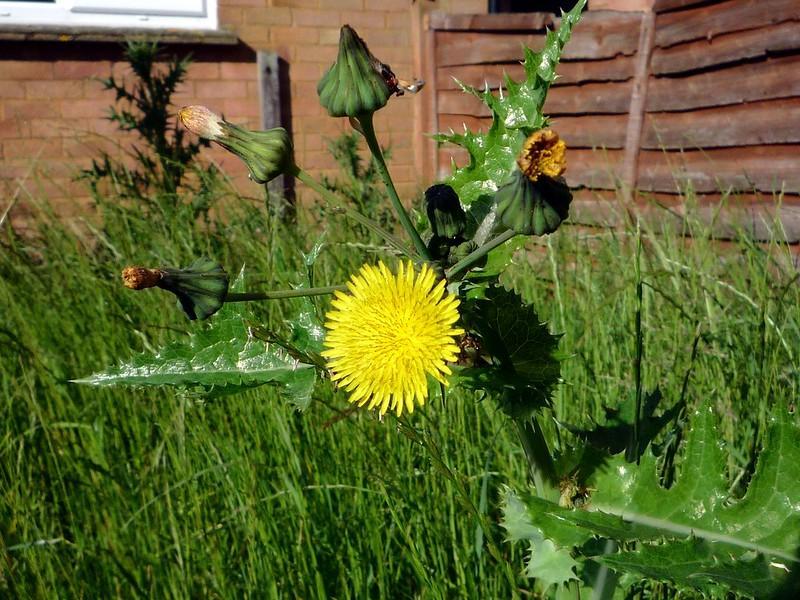
Spiny Sowthistle: A noxious weed of many regions and countries.
It is a herbaceous wildflower with yellow flowers and spiky leaves. Because of its aggressive growth, the plant is often considered a weed. It grows in full sun and can grow well in many different types of soil with varying moisture levels.
These weeds are usually found in wasteland areas and attract people’s attention as their seed heads are filled with pappus.
They can be removed by uprooting the plants; however, a weak taproot results in the upper part of the plant breaking off. The taproot, after a while, can give rise to a new plant.
Spiny Sowthistle Quick Facts
| Scientific Name | Sonchus asper |
| Other Names | Prickly sow thistle, sharp-fringed sow thistle, rough milk thistle, spiny-leaved sow thistle |
| Weed Type | Annual or biennial herb |
| Height | 4 to 80 inches |
| Flowering & Leaves | – Flowering occurs from June to August – Flowers are golden or yellow and are present in clusters – Leaves are curved and have very spiny teeth |
| Distribution & Habitat | – Native to Europe, North Africa, and western Asia – Naturalized in other continents |
Common Teasel
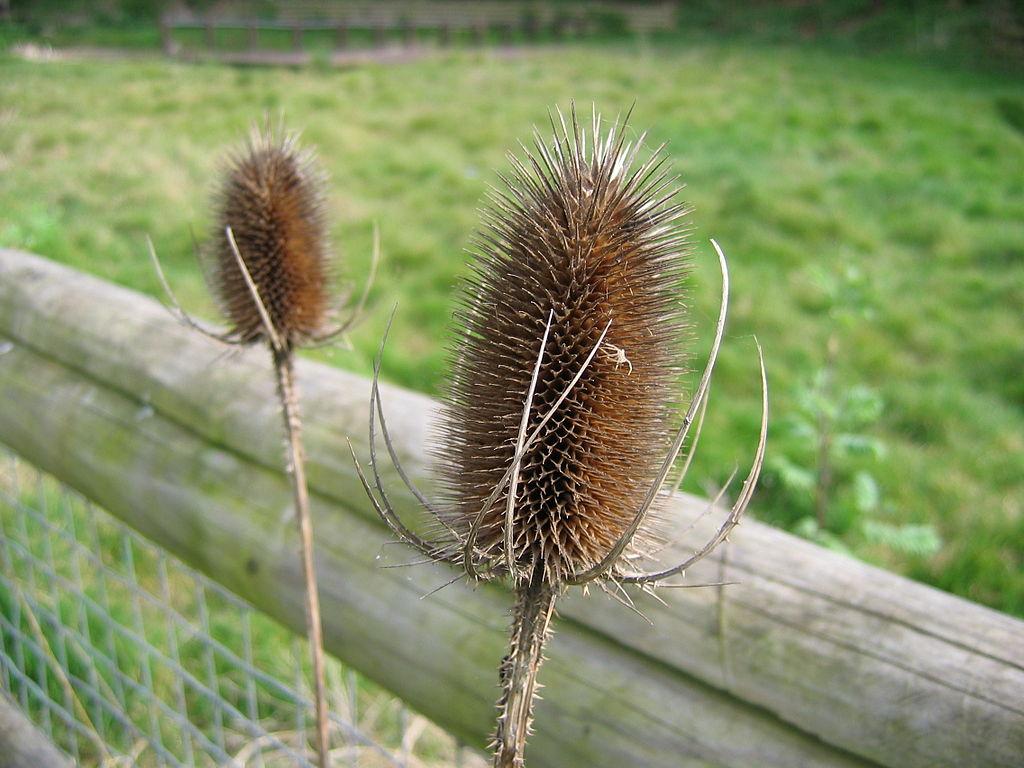
Common teasel is listed as a noxious weed in Iowa, United States.
The common teasel is a monocarpic, tap-rooted plant that dies after producing seeds. In the past, it was a common weed of disturbed areas such as roadsides. However, in recent years, it has started invading agricultural lands in many regions of the United States. Nowadays, it is also found growing in prairies, meadows, and savannas.
The plants reproduce via seeds that do not spread very far from the parent plant. Common teasel tends to make dense colonies over a relatively small area. Controlling the spread of common teasel requires a multi-pronged approach.
The key to controlling an infestation and its spread is to prevent the seeds from spreading. Also, encouraging the growth of native plants and maintaining healthy lawn and garden conditions can reduce the chances of reinfestation.
Common Teasel Quick Facts
| Scientific Name | Dipsacus fullonum |
| Other Names | Fuller’s teasel, wild teasel |
| Weed Type | Biennial or short-lived perennial |
| Height | Up to 7 feet |
| Flowering & Leaves | – Flowers are spiny and persist throughout winter – Flowers are purple, dark pink, or lavender – Leaves are lance-shaped, triangular, and have spines |
| Distribution & Habitat | – Native to Eurasia and North Africa – Introduced and widespread in the Americas, Australia, and New Zealand – Habitats include open and sunny areas |
Burr Medic
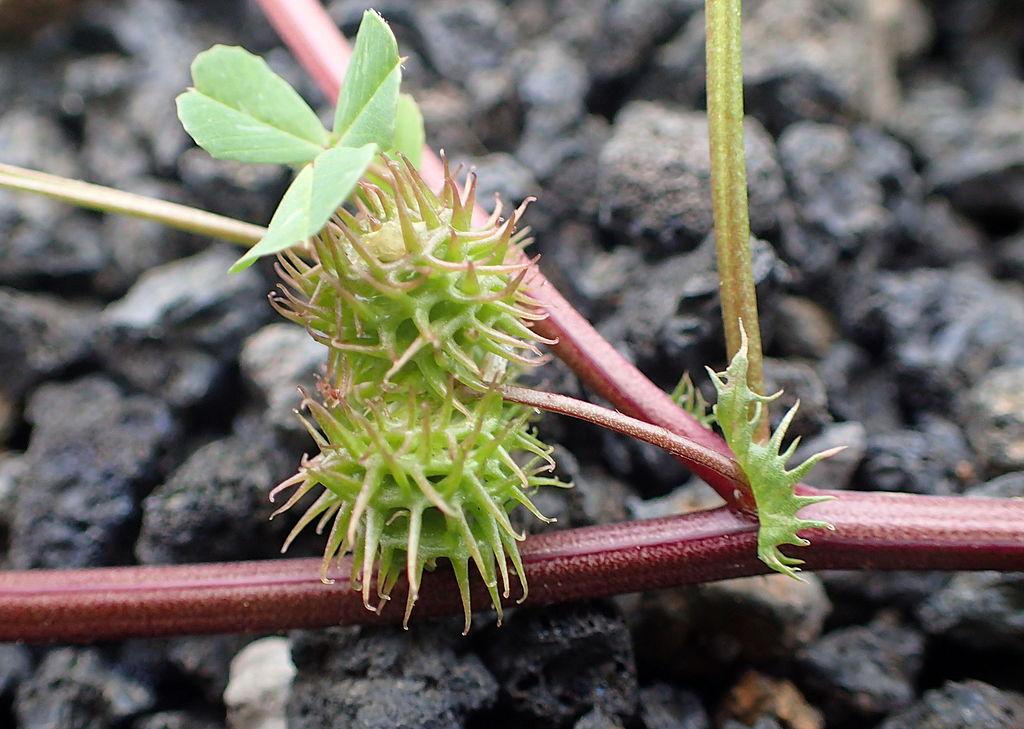
Leaves and spines of a burr medic plant.
Burr Medic is a type of trifoliate weed that can quickly take over entire gardens and lawns if not controlled. It is regarded as an environmental weed in New South Wales and Western Australia. Burr medic is usually found in disturbed sites, waste areas, parks, lawns, gardens, and other turfed areas.
Burr medic is hard to control by cutting and mowing as the plant quickly regrows. Also, it is resistant to several herbicides. The best way to control burr weed is by removing plants when young and preventing mature plants from spreading seeds.
Burr Medic Quick Facts
| Scientific Name | Medicago polymorpha |
| Other Names | California burclover, toothed medick, toothed bur clover |
| Weed Type | Annual |
| Height | Up to 14 inches |
| Flowering & Leaves | – Flowers are clover-like and clustered – Leaves are also clover-shaped |
| Distribution & Habitat | Commonly found in open grasslands, shrublands, and woodlands |
Frequently Asked Questions (FAQs)
What are those prickly weeds called in my yard?
Many weeds are prickly and spiny. Besides the types mentioned above, Litchi tomato, Balloon plant, and Prickly paddy melon are also spiky weeds you might encounter in your lawn or garden.
How do you get rid of spiky lawn weeds?
Hand pulling is usually not recommended for spiny lawn weeds that you might come across in your garden beds. Instead, try using a garden fork or any other available tools to remove these nasty lawn weeds from the lawn. Sometimes, you might also need to use chemical control methods to free your garden beds of spiky plants.
What is spiky grass?
If you come across a patch of spiky grass while walking around your lawn, chances are, it is a spiny weed. Depending on the species, these lawn weeds can not only become a nuisance but can also compete aggressively with other plants in your lawns, gardens, and flower beds. Therefore, it is better to get rid of these nasty plants as soon as possible.
Sources for Further Reading
- Weed identification. (2022). Retrieved 10 April 2022, from https://extension.umn.edu/weed-management/weed-identification
- Plant and Weed Identification. (2022). Retrieved 10 April 2022, from https://www.canr.msu.edu/pestid/resources/plant-and-weed-identification/index
After reading this list of spiky weeds make sure to also check out our other articles:
11 Outdoor Foliage Plants To Arrange Your Garden Like A Professional Landscape Designer
Bothers, Be Gone: The Ultimate Guide To Begonias
5 Breath-taking Types Of Calathea For Your Private Tropic Corner







